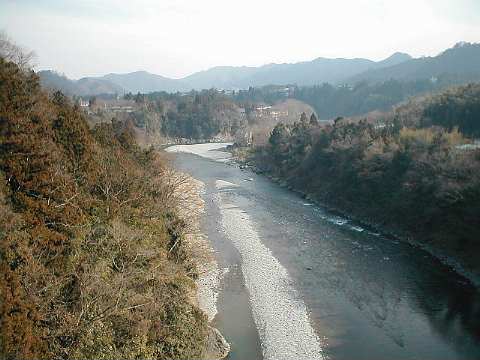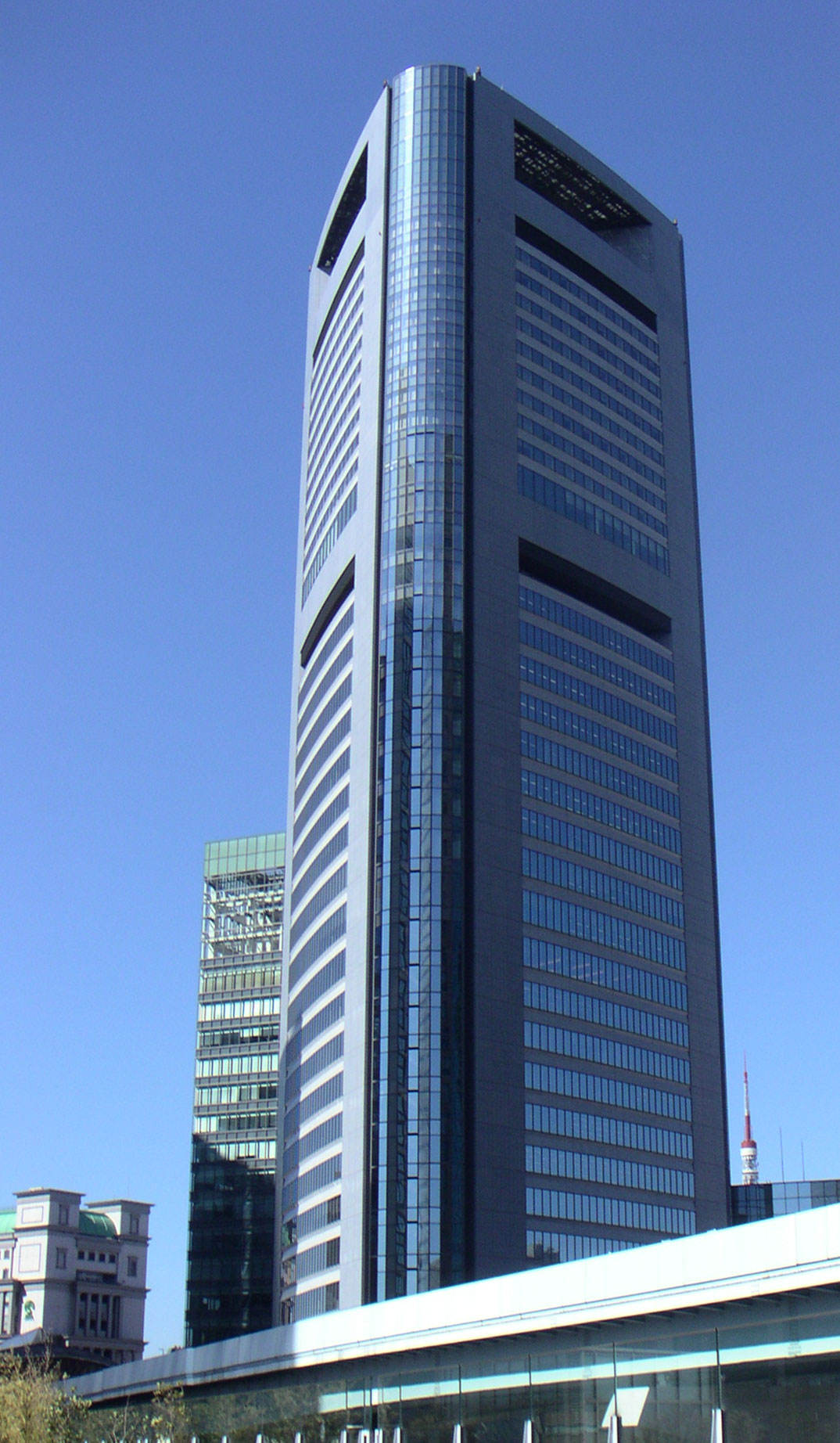|
Fuchūhommachi Station
is a junction passenger railway station located in the city of Fuchū, Tokyo, Japan, operated by East Japan Railway Company (JR East). Lines Fuchūhommachi Station forms the western terminus of the orbital Musashino Line from and Tokyo, and is also served by the Nambu Line from to . It is located 22.8 kilometers from Tsurumi Station on the Musashino Line and 27.9 kilometers from Kawasaki Station on the Nambu Line. Station layout The station consists of a central island platform serving two terminating tracks for the Musashino Line, with two side platforms on either side serving the Nambu Line tracks. Through tracks are used by freight trains continuing to and from on the freight-only Musashino South Line. The station building is elevated and is located above the tracks and platforms. The station has a "Midori no Madoguchi" staffed ticket office. Platforms File:Fuchu Honmachi-2006-07-11.jpg, View from Nambu Line platform 1 with the Musashino Line stabling sidings visi ... [...More Info...] [...Related Items...] OR: [Wikipedia] [Google] [Baidu] |
Fuchū, Tokyo
260px, Fuchū City Hall is a city located in western Tokyo Metropolis, Japan. Fuchū serves as a regional commercial center and a commuter town for workers in central Tokyo. The city hosts large scale manufacturing facilities for Toshiba, NEC and Suntory, as well as the Bank of Japan's main computer operations center. Local sporting attractions include the Tokyo Racecourse and the training grounds of Top League rugby teams Toshiba Brave Lupus and Suntory Sungoliath. , the city had an estimated population of 260,508, and a population density of 8,900 persons per square kilometer. The total area of the city is . Geography Fuchū is located approximately 20 km west of the centre of Tokyo. Using the Keiō Line from Shinjuku, it is 25 minutes to Fuchū Station (main station). It spreads across the Musashino Terrace on the left bank of the Tama River, facing the Tama hills on the opposite shore. The Tama River flows through the southernmost end of the city from west to east. ... [...More Info...] [...Related Items...] OR: [Wikipedia] [Google] [Baidu] |
Fuchū Station (Tokyo)
is a passenger railway station located in the city of Fuchū, Tokyo, Japan, operated by the private railway operator Keio Corporation. It is numbered "KO24". Lines Fuchū Station is served by the 37.9 km Keio Line from to , and is located 21.9 km from the Tokyo terminus of the line at Shinjuku. Station layout This station consists of two island platforms serving four tracks, with each platform on a passing loop. Platforms History The station opened on 31 October 1916. The new elevated station building opened on 1 March 1993. Passenger statistics In fiscal 2019, the station was used by an average of 88,769 passengers daily. The passenger figures (boarding passengers only) for previous years are as shown below. Surrounding area * * Fuchū City Office * * Fuchū-Hommachi Station on the JR Musashino Line and Nambu Line See also * List of railway stations in Japan The links below contain all of the 8579 railway stations in Japan. External links {{P ... [...More Info...] [...Related Items...] OR: [Wikipedia] [Google] [Baidu] |
Stations Of East Japan Railway Company
Station may refer to: Agriculture * Station (Australian agriculture), a large Australian landholding used for livestock production * Station (New Zealand agriculture), a large New Zealand farm used for grazing by sheep and cattle ** Cattle station, a cattle-rearing station in Australia or New Zealand **Sheep station, a sheep-rearing station in Australia or New Zealand Communications * Radio communication station, a radio frequency communication station of any kind, including audio, TV, and non-broadcast uses ** Radio broadcasting station, an audio station intended for reception by the general public ** Amateur radio station, a station operating on frequencies allocated for ham or other non-commercial use ** Broadcast relay station ** Ground station (or Earth station), a terrestrial radio station for extraplanetary telecommunication with satellites or spacecraft ** Television station * Courier station, a relay station in a courier system ** Station of the ''cursus publicus'', a sta ... [...More Info...] [...Related Items...] OR: [Wikipedia] [Google] [Baidu] |
Railway Stations In Japan Opened In 1928
Rail transport (also known as train transport) is a means of transport that transfers passengers and goods on wheeled vehicles running on rails, which are incorporated in tracks. In contrast to road transport, where the vehicles run on a prepared flat surface, rail vehicles (rolling stock) are directionally guided by the tracks on which they run. Tracks usually consist of steel rails, installed on sleepers (ties) set in ballast, on which the rolling stock, usually fitted with metal wheels, moves. Other variations are also possible, such as "slab track", in which the rails are fastened to a concrete foundation resting on a prepared subsurface. Rolling stock in a rail transport system generally encounters lower frictional resistance than rubber-tyred road vehicles, so passenger and freight cars (carriages and wagons) can be coupled into longer trains. The operation is carried out by a railway company, providing transport between train stations or freight customer faciliti ... [...More Info...] [...Related Items...] OR: [Wikipedia] [Google] [Baidu] |
List Of Railway Stations In Japan ...
The links below contain all of the 8579 railway stations in Japan. External links {{Portal bar, Japan, Trains * Railway stations Japan Japan ( ja, 日本, or , and formally , ''Nihonkoku'') is an island country in East Asia. It is situated in the northwest Pacific Ocean, and is bordered on the west by the Sea of Japan, while extending from the Sea of Okhotsk in the north ... [...More Info...] [...Related Items...] OR: [Wikipedia] [Google] [Baidu] |
Tama River
The is a major river in Yamanashi, Kanagawa and Tokyo Prefectures on Honshū, Japan. It is officially classified as a Class 1 river by the Japanese government. Its total length is , and the total of the river's basin area spans . The river flows through Tokyo, on the dividing line between Tokyo and Kanagawa. In the city, its banks are lined with parks and sports fields, making the river a popular picnic spot. Course The Tama's source is located at Mt. Kasatori in Koshu in Yamanashi Prefecture. From there, it flows eastward into mountainous western Tokyo, where the Ogōchi Dam forms Lake Okutama. Below the dam, it takes the name Tama and flows eastwards through Chichibu Tama Kai National Park towards Ōme, Tokyo. It then flows southeast between Tama Hills and Musashino Terrace. At Hamura is the source of the historic Tamagawa Aqueduct built by the Tamagawa brothers in 1653 to supply water to Edo (present day Tokyo). Further downstream, the river forms the boundary betw ... [...More Info...] [...Related Items...] OR: [Wikipedia] [Google] [Baidu] |
Kyodo No Mori
is a nonprofit cooperative news agency based in Minato, Tokyo. It was established in November 1945 and it distributes news to almost all newspapers, and radio and television networks in Japan. The newspapers using its news have about 50 million subscribers. K. K. Kyodo News is Kyodo News' business arm, established in 1972.Shrivastava, K. M. (2007). ''News agencies from pigeon to internet.'' Sterling Publishers Pvt. Ltd. p. 208. . The subdivision Kyodo News International, founded in 1982, provides over 200 reports to international news media and is located in Rockefeller Center, New York City. Their online news site is in Japanese, Chinese ( Simplified and Traditional), Korean, and English English usually refers to: * English language * English people English may also refer to: Peoples, culture, and language * ''English'', an adjective for something of, from, or related to England ** English national ide .... The agency employs over 1,000 journal ... [...More Info...] [...Related Items...] OR: [Wikipedia] [Google] [Baidu] |
Ōkunitama Shrine
is a shrine located in Fuchū, Tokyo, Japan. Six shrines in Musashi province were consolidated and their gods enshrined there. Ōkunitama is now known as one of the five major shrines in Tokyo, the others being the Tokyo Great Shrine, Yasukuni Shrine, Hie Shrine and Meiji Shrine. General description Within the shrine complex, there are many buildings and points of interest. The main shrine buildings are in an walled inner complex protected by an inner and outer gate. The main shrine is dedicated to Ōkuninushi. In addition, the main shrine is also an amalgamation of branches of the six main shrines from around Musashi Province: In addition, the main shrine complex is surrounded by seven smaller subsidiary shrines. These are ''Matsuo Shrine'', ''Tatsumi Shrine'', ''Tōshōguu Shrine'', ''Sumiyoshi Shrine'', ''Ōwashi Shrine'', ''Miyanome Shrine'' and an '' Inari shrine''. There is also a sumo ring and a Russo-Japanese War memorial, as well as the remains of the former Musa ... [...More Info...] [...Related Items...] OR: [Wikipedia] [Google] [Baidu] |
Tokyo Racecourse
is located in Fuchu, Tokyo, Japan. Built in 1933 for horse racing, it is considered the "racecourse of racecourses" in Japanese horseracing. It has a capacity of 223,000, with seating for 13,750. Tokyo Racecourse hosts numerous G1 (Grade 1) races, including the Japan Cup, Tokyo Yushun (the Japanese Derby) and the Yasuda Kinen, a part of the Asian Mile Challenge. Physical attributes Tokyo Race Course's grass course measures 2083m (1¼ miles + 234 feet) with two chutes (1800m and 2000m). Races can be run on the "A Course" rail setting (on the hedge), the "B Course" setting (rail out 3 meters), the "C Course" setting (rail out 6 meters), the "D Course" setting (rail out 9 meters) or the "E Course" setting (rail out 12 meters). The dirt course measures 1899 meters (1⅛ mile + 290 feet), with a 1600m chute. The jump course measures 1675 meters (1 mile + 215 feet). There was a chute for 3200m races (used for the Tenno Sho Autumn races), but when the race was shortened to 2000m, ... [...More Info...] [...Related Items...] OR: [Wikipedia] [Google] [Baidu] |
Bubaigawara Station
is an interchange passenger railway station located in the city of Fuchū, Tokyo, Japan, operated jointly by the East Japan Railway Company (JR East) and the private railway operator Keio Corporation. Lines Bubaigawara Station is served by the Nambu Line, and is 28.8 kilometers from the Nambu Line terminus at Kawasaki Station. It is also served by the Keiō Line, and is 23.1 km from the Keio Line Tokyo terminus at Shinjuku. Station layout The JR East and Keio Stations each have two side platforms serving two tracks. The two parts of the station share a common station building and entrance, with both JR and Keio ticket vending machines located side by side. JR East platforms The JR East platforms are located at ground level, running west to east. File:JRBubaigawaraStationPlatforms-Jan2014.jpg, The Nambu Line platforms viewed from a level crossing to the east of the station, January 2014 File:Bubaigawara Station 20130309.JPG, The Nambu Line platforms looking east ... [...More Info...] [...Related Items...] OR: [Wikipedia] [Google] [Baidu] |
Keiō Keibajō Line
The is a railway line in Fuchū, Tokyo, Japan, owned and operated by the private railway operator Keio Corporation. It connects on the Keiō Line and , and services the Tokyo Racecourse as well as the surrounding suburbs. Services During weekdays served by two-car local trains goes back and forth between Higashi-Fuchū and Fuchūkeiba-seimommae, while on weekends and holidays (as well as during events at the nearby Tokyo Racecourse) 8-car and 10-car local and express trains are operated through from the Keiō Line The is a 37.9-km railway line in western Tokyo, Japan, owned by the private railway operator Keiō Corporation. It connects Shinjuku, Tokyo, with the suburban city of Hachiōji. The Keiō Line is part of a network with interchanges and throug .... Stations History The line opened on 29 April 1955 as dual track electrified at 600 VDC. The voltage was increased to 1500 VDC in 1963. References This article incorporates material from the corresponding article in ... [...More Info...] [...Related Items...] OR: [Wikipedia] [Google] [Baidu] |




